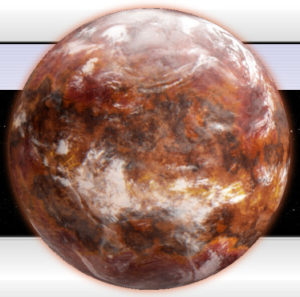These are the giant Earth-like worlds.
Sounds like lots of extra space? Be careful; bigger planets generally mean more gravity, so you have to find the ones that are less dense, or at least rotating more quickly, or have some other means of offsetting their size/mass so that they are still livable without much technology/terraforming. On normal/average Helian (“Super-Earth”) worlds, you simply have too much gravity to endure/tolerate without very specialized (anti-gravity) devices/rooms.
–
Helian Group (X Y Z)
mass 3 to 17 Earth, enough to retain helium atmospheres.
Geo-Helian:
mass 3 – 15 Earth, lack a layer of liquid or super-condensed volatiles, having either expended them long ago, or never having had them to begin with.
Older, more stable regions may be heavily cratered, but much of the surface tends to be geologically young.
- Halcyonic: silicon-rich, orbits tight solar, mass 5-15 Earth. Substantial surface volcanic activity, and though the atmosphere is quite dense, it is relatively cloudless due to the extremely high temperatures. Surface /appear is thus visible from space, but still partially obscured by the sheer thickness of the atmosphere, which from space appears as a blue haze, especially pronounced along the limb of the planet.
- Hyperionic: silicate-rich, mass 5 – 13 Earth. Substantial surface volcanic activity, large greenhouse effect which is slightly off-set by a cloudy atmosphere of yellowish sulfuric acid or water clouds. Surface extremely hot, well outside the range for life.
- Thetusean: carbon-rich, tight solar orbits, mass 5 – 15 Earth. Substantial surface volcanic activity, atmosphere quite dense, thick with dark clouds of hydrocarbon soot. Surface extremely hot due to a combination of a very strong greenhouse effect and the low albedo of the hydrocarbon clouds.
- Metusean: Abundant: carbon. Mass: 4-13 Earth. Surface: substantial volcanic, extremely hot, well outside range for life. Liquid bodies: may be lakes/oceans of thick hydrocarbon tar. Atmosphere: large greenhouse effect offset by: Cloudy. Appears: Atmosphere of white water, brown ammonium hydro-sulfide, or cream-colored ammonia clouds.
- Solarian: Abundant: carbide. Orbit: tight solar. Mass: 5-15 Earth. Temperature: extremely high/hot. Surface: substantial volcanic, visible from Space, partially obscured by sheer thickness of atmosphere. Liquid bodies: Atmosphere: quite dense, relatively cloudless due to extremely high temperatures. From Space: appears as reddish haze especially pronounced along the limb of the planet.
- Thean: ice-rich, mass 3 – 10 Earth, beyond snow-line.
Nebulous
mass 3 – 15 Earth.
atmospheres extremely dense ,support a layer of super-condensed volatiles.
- Geo-Nebulous: mass 5 – 15 Earth. Temperature: extremely hot. Composed primarily of silicates, their thin crusts riddled with tectonic activity. This activity may be of the degree that there are entire lakes or seas of magma. Within years, the surfaces can be completely turned over. Atmospheres: thick , dense, supporting massive greenhouse effect and sometimes comprising up to 10% of the planet’s mass.
- Cryo-Nebulous: mass 4 – 10 Earth. Orbit /form beyond the snow-line, composed of a roughly equal mixture of ice and rock. Due to their mass their crusts are thin and riddled with cryo-volcanic activity, which serve to keep their surfaces fairly smooth. Atmospheres thick and dense, sometimes comprising up to 10% of the planetary mass.
Panthalassic:
mass 3 – 13 Earth.
aborted gas giants, having initially begun their formation beyond their solar system’s snow-line. However, tidal dragging caused by interactions with the accretion disk caused them to migrate inward of the snow-line, where their growth was slowed or halted due to the sudden lack of abundant icy materials (which swiftly feed the growth of Jovian worlds). However, being composed of largely icy materials, they develop tremendously deep oceanic surfaces and thick atmospheres of water, hydrogen, and oxygen.
–
Class X:

–
Class Y:

–
Class Z:
–

